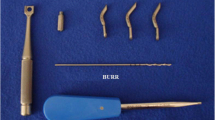Abstract
A total of 118 feet with Hallux valgus and Hallux rigidus treated by the Keller-Brandes method were re-examined clinically and radiologically after 9.1 years (range: 1.7–24.3). Correction of the Hallux valgus angle was obtained from an average of 40° to 23° in the Hallux valgus group. Improvement in the postoperative range of motion was observed when the aftertreatment consisted of Kirschner-wire distraction instead of an axial Kirschner-wire transfixation. The patients who underwent Keller-Brandes surgery for Hallux valgus had less pain when the aftertreatment was carried out using an axial Kirschner wire, while those operated on for Hallux rigidus had less pain when the aftertreatment consisted of distraction. The percentage of satisfied or very satisfied patients with the cosmetic results of the Keller-Brandes arthroplasty was more than 66.7%. Patients with Hallux valgus and postoperative aftertreatment with Kirschner wire transfixation were the most satisfied patients, while patients with Hallux rigidus were very satisfied with the postoperative distraction. Our good results are comparable to those in other studies and confirm the success of the Keller-Brandes resection arthroplasty in Hallux valgus with osteoarthritis of the first metatarsophalangeal joint in older patients whose demand for movement is less, and in Hallux rigidus in less active older patients.
Résumé
Cent dix huit pieds avec hallux valgus arthrosique ou hallux rigidus, opérés par la méthode de Keller-Brandes ont été examinés après un délai moyen de 9,1 ans (1,7–24,3). L’amélioration de l’hallux valgus était en moyenne de 40 à 23 degrés. Dans les hallux valgus l’amélioration de la mobilité était constaté quand le traitement post-opératoire était une extension par broche de Kirschner plutôt qu’une immobilisation par brochage axial. Les patients opérés pour hallux valgus avaient moins de douleurs quand était utilisé un brochage axial et ceux opérés pour hallux rigidus en avaient moins quand était utilisé une extension. Plus de 66,7% des patients étaient satisfaits ou très satisfaits des résultats cosmétiques de l’opération. Les patients avec hallux valgus étaient plus satisfaits quand était utilisée le brochage axial et les patients avec hallux rigidus étaient plus satisfaits quand une extension post-opératoire était utilisée. Nos bons résultats sont comparables avec cuex d’autres séries et confirme le succés de la résection arthroplastie de Keller-Brandes pour les hallux valgus avec arthrose de la première métatarsophalangienne chez les patients âgés peu demandeurs et pour les hallux rigidus chez les patients âgés peu actifs.



Similar content being viewed by others
References
Brandes M (1929) Zur operativen Therapie des Hallux valgus. Zbl Chir 56:2434–2440
Breitenseher MJ, Toma CD, Gottsauner-Wolf F, Imhof H (1996) Hallux rigidus operiert nach Keller und Brandes: Radiologische Erfolgs- und Prognoseparameter. Fortschr Röntgenstr 164:483–488
Burckhardt A, Abbühl U (1991) Die Behandlung des Hallux valgus mit der Operation nach Keller/Brandes-Indikation, Operationsmethode und Ergebnisse. Ther Umsch 48:824–831
Donley B, Vaughn R, Stephenson K, Richardson E (2002) Keller resection arthroplasty for treatment of hallux valgus deformity: increased correction with fibular sesamoidectomy. Foot Ankle Int 23:699–703
Fuhrmann R, Anders J (2001) The long-term results of resection arthroplasties of the first metatarsophalangeal joint in rheumatoid arthritis. Int Orthop 25:312–316
Haaker R (1999) Is the Keller Brandes operation still of current value? Z Orthop Ihre Grenzgeb 137:0A3
Keiserman L, Sammarco V, Sammarco G (2005) Surgical treatment of the hallux rigidus. Foot Ankle Clin 10:75–96
Keller WL (1904) The surgical treatment of bunions and hallux valgus. NY Med J 80:741–742
Keller WL (1912) Further observations on the surgical treatment of hallux valgus and bunions. NY Med J 95:696–698
Kleinod G (1990) Ergebnisse verschiedener Hallux-valgus-Operationen. Beitr Orthop Traumatol 37:177–181
Leonhardt K (1990) Ergebnisse von Hallux-valgus-Operationen nach Keller/Brandes. Beitr Orthop Traumatol 37:510–517
Machacek F, Easley M, Gruber F, Ritschl P, Trnka H (2005) Salvage of the failed Keller resection arthroplasty. Surgical technique. J Bone Joint Surg Am 87:86–94
Mann A, Rudicel S, Graves S (1992) Repair of hallux valgus with a soft-tissue procedure and proximal metatarsal osteotomy. J Bone Joint Surg Am 74-A:124–129
Toma C (1994) Die Operation nach Keller-Brandes zur Behandlung des Hallux rigidus. Klinisch radiologische Analyse der Langzeitergebnisse. Wien Klin Wochenschr 106/12:381–383
Turnbull T, Grange WA (1986) Comparison of Keller’s arthroplasty and distal metatarsal osteotomy in the treatment of adult hallux valgus. J Bone Joint Surg Br 68-B:132–137
Vallier G, Petersen S, LaGrone M (1991) The Keller resection arthroplasty: a 13-year experience. Foot Ankle 11:187–194
Viladot R, Rochera R, Alvarez F, Pasarin A (1996) Die Resektionsarthroplastik zur Behandlung des Hallux valgus. Orthopäde 25:324–331
Weber A (1975) Ergebnisse der operativen Korrektur des Hallux valgus beim jungen Patienten. Z Orthop 113:1011–1021
Willkommen H (1979) Spätergebnisse der Hallux-valgus-Operationen nach Brandes und Mayo. Beitr Orthop Traumatol 26:385–391
Zembsch A, Trnka H, Menschik G, Ritschl P (1999) Keller-Brandes operation: long-term outcome in young patients with hallux valgus. Z Orthop Ihre Grenzgeb 137:181–188
Author information
Authors and Affiliations
Corresponding author
Appendix
Appendix
Burckhardt and Abbühl (1991) Classification for Keller-Brandes surgery.
Very good:
No pain, normal shoes, unlimited walking ability, normal function of the great toe, valgus position <20°.
Good:
No pain of the great toe, mild metatarsalgia, walking capacity unlimited in good shoes, valgus angle of between 20 and 30°.
Moderate:
Pain of the great toe, slightly limited walking capacity, requires only orthopedic inner soles, valgus angle >30°.
Poor:
Considerable pain, walking capacity clearly limited, requires orthopedic shoes, valgus angle unchanged.
Rights and permissions
About this article
Cite this article
Reize, P., Schanbacher, J. & Wülker, N. K-wire transfixation or distraction following the Keller-Brandes arthroplasty in Hallux rigidus and Hallux valgus?. International Orthopaedics (SICOT) 31, 325–331 (2007). https://doi.org/10.1007/s00264-006-0178-8
Received:
Revised:
Accepted:
Published:
Issue Date:
DOI: https://doi.org/10.1007/s00264-006-0178-8




